An interview with Tropical Salvage’s Tim O’Brien
Salvage logging offers hope for forests, communities devastated by industrial logging
Rhett A. Butler, mongabay.com
December 4, 2008
|
|
As currently practiced, logging is responsible for large-scale destruction of tropical forests. Logging roads cut deep into pristine rainforests, opening up once remote areas to colonization, subsistence and industrial agriculture, wildlife exploitation, and other forms of development. Timber extraction thins the canopy, damages undergrowth, and tears up soils, reducing biodiversity and leaving forests more vulnerable to fire. Even selective logging — the dominant form of timber extraction in the tropics — is damaging. Once timber of commercial interest is harvested, forest land is increasingly burned to create grazing pasture or land for farming. In Southeast Asia — especially Indonesia and Malaysia — vast tracts of logged forest have been converted for rubber and oil palm plantations. Land that is not converted for agriculture is often colonized by grasses that prevent forest recovery.
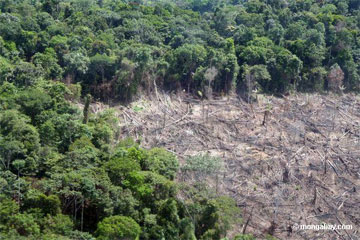 Photo by Rhett A. Butler |
While recent years have seen the emergence of sustainable harvesting techniques and certification systems like the Forest Stewardship Council (FSC) for timber, many ecologists believe that industrial logging of old-growth rainforests in inherently unsustainable. Selectively logged forests biologically impoverished relative to unlogged forests and far more susceptible to future clearing.
Nevertheless demand for wood products continues to grow. China is expected to import more than 100 million cubic meters of industrial roundwood by 2010, much of which will go into finished products shipped off to Europe and the United States. As much as 60 percent of this is illicitly sourced. Meanwhile in Brazil domestic hunger for timber is fueling widespread illegal logging of the Amazon rainforest. Armed standoffs between environmental police and people employed by unlicensed operators are increasingly common.
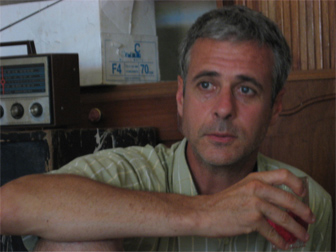 Tim O’Brien, founder of Tropical Salvage. Photo by Edward Wolf |
Tropical Salvage, a Portland, Oregon-based producer of wood products, is avoiding these issues altogether by taking a different approach to meet demand for products made from high-quality tropical hardwoods. The company salvages wood discarded from building sites, unearthed from mudslides and volcanic sites, and dredged from rivers and reservoirs in Indonesia and turns it into premium wood products. In the process, Tropical Salvage is putting formers loggers to work and supporting a conservation, education and reforestation project on Java.
Tim O’Brien, founder of Tropical Salvage (tropicalsalvage.com), says the idea for the company came during a 1998 visit to Indonesia. In his tour of several islands, O’Brien was struck by the volume of wood discarded as wooden structures were being replaced by concrete and rebar ones. At the same time he was appalled by a tract of beautiful and biologically-rich primary rainforest laid waste by logging near Gunung Leseur National Park.
“It looked like a particularly psychotic episode of vandalism,” he told mongabay.com. “A place that had been one of the most biologically diverse spots on earth since time immemorial had, in the course of a few months, been reduced to an eerie, silent ruin of power-saw litter. It was ominous and affecting.”
“The rightness and wrongness of our management of tropical forests might be aptly illustrated by looking down the line formed by a still standing primary forest abutting a clear-cut forest,” he continued. “The cut side appears exactly like what it is: reckless squander driven by short-sighted business interests. The forest’s role as an invaluable multi-faceted resource is ended. The living side illustrates a world in which we thoughtfully and respectfully observe, interact with, derive pleasure from and learn to use the full spectrum of life’s phenomena.”
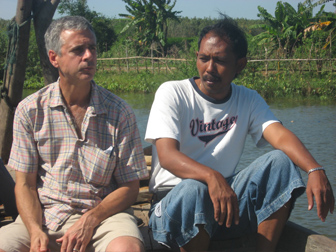 O’Brien with Agus Rafiqkoh, who leads the Tropical Salvage team in Indonesia. According to Kevin Havice, O’Brien’s associate at Tropical Salvage, “Without Agus, Tropical Salvage would not be possible.” |
O’Brien was inspired to launch a wood-products company that wouldn’t contribute to the sort of scene he had witnessed. He was also moved to support a project — the Jepara Forest Conservancy — that would help restore what has been lost.
“Tropical Salvage has provided the seed capital for and significantly helped to shape and implement the Jepara Forest Conservancy, an Indonesian non-profit “yayasan” formed by a group of citizens from Jepara and Kudus concerned about environmental degradation and sustainable economic development on the Mount Muria peninsula, located in north central Java, Indonesia,” he said. “Guiding the Jepara Forest Conservancy’s vision are principles that forestry-based climate change mitigation projects must be fully integrated with climate change adaptation strategies and that environmental protection is best achieved by working together with site communities to combine environmental objectives with generating sustainable livelihoods and cultural resilience.”
In a December 2008 interview with mongabay.com, O’Brien discussed his work with Tropical Salvage and the Conservancy.
AN INTERVIEW WITH TIM O’BRIEN
Mongabay: How did Tropical Salvage get started and what was your inspiration?
Tom O’Brien: The idea for Tropical Salvage occurred during a visit to Indonesia in 1998. Two observations encouraged the idea. First, wherever I traveled in Java, Bali, Lombok and Sumbawa, I noticed old wooden structures being replaced by new structures built from concrete and rebar. In many instances no plan existed to re-use the old beams, boards and poles. Old, hand-hewn wood deriving from mature, tight-grained, tropical hardwood trees was fueling cooking fires. The idea was also inspired by a visit to Gunung Leseur National Park, in western Sumatra. In a week of trekking, we encountered an astonishing array of wildlife, including six different species of primates, monitor lizards as long as canoes, several types of snakes, numerous exotic birds, butterflies and other small creatures, and a fantastically diverse population of enormous trees in which most of the creatures made their homes.
Along the way, we also encountered a vast area of recently clear-cut primary forest. It looked like a particularly psychotic episode of vandalism. A place that had been one of the most biologically diverse spots on earth since time immemorial had, in the course of a few months, been reduced to an eerie, silent ruin of power-saw litter. It was ominous and affecting.
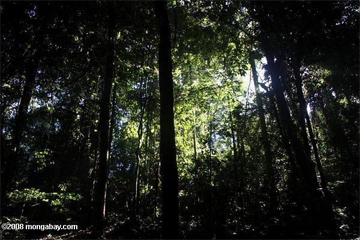 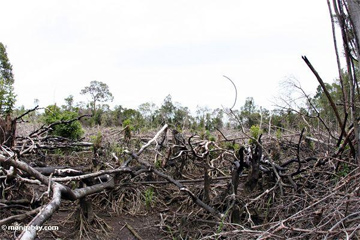 Primary and logged forest in Borneo. Photo by Rhett A. Butler |
The rightness and wrongness of our management of tropical forests might be aptly illustrated by looking down the line formed by a still standing primary forest abutting a clear-cut forest. The cut side appears exactly like what it is: reckless squander driven by short-sighted business interests. The forest’s role as an invaluable multi-faceted resource is ended. The living side illustrates a world in which we thoughtfully and respectfully observe, interact with, derive pleasure from and learn to use the full spectrum of life’s phenomena.
The experience in Sumatra was so disturbing that I couldn’t passively absorb it into a complex world’s expanding landscape of unsettling experience. Living in the “age of information,” when science has made clear the dependency of human quality of life on eco-system integrity, asserting a more active role in contributing to tropical forest conservation seemed a useful course to follow.
Mongabay: What is your primary area of operation? Do you work in areas where logging as a source of employment has declined to due resource depletion?
Tom O’Brien: We work mainly in central and eastern Java but have also sourced from Sumatra, Lombok and Sumbawa. Yes, logging as a source of employment has declined precipitously on all of the islands where we work. Also, quality of life among the islands’ inhabitants has declined as a result of diminished ecosystem services caused by irresponsible clear-cut logging strategies.
Mongabay: Is it unusual for a U.S.-based wood products seller to have a vertically integrated system with direct harvesting overseas?
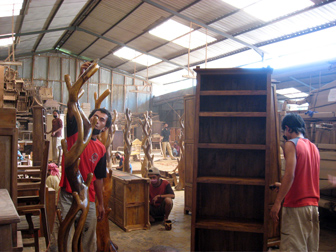 Tropical Salvage craftsmen at work. Photo by Edward Wolf |
Tom O’Brien: Yes, it is. Furthermore, not having a vantage allowed by vertical integration makes it difficult to know sourcing streams. For example, China currently supplies most of the world’s wood furniture. Experts who study the supply streams that feed this enormous material demand estimate that over 60% of wood used by Chinese manufacturers to answer the developed world’s demand for furniture, flooring and other wood products is illegally sourced – through relationships with corrupt political and military officials in Russia, Indonesia, Myanmar and Laos. Some documentation certifying “responsible sourcing” – “phytosanitary certificates” in Indonesia, for example – can be easily bought from corrupt government employees, thus further obscuring sourcing scenarios.
Mongabay: Harvesting timber from lakes, volcanic deposits, and landslides must present many challenges. Are harvesting costs significantly higher than conventional-logging? Is there enough “salvageable” timber to make this a long-term model?
Tom O’Brien: Yes, our wood sourcing strategies pose more logistical challenges than straightforward forest or plantation wood harvests. Our labor costs are higher, as we employ many more hands to deconstruct structures or work trees out of rivers, the ground and landslide debris piles. Much of our wood is significantly less expensive because we’ve learned to use a variety of species, distressed by a variety of conditions, that weren’t previously regarded as appropriate to building furniture.
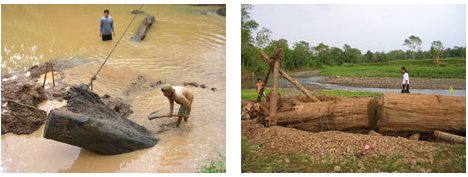 Salvaging timber from rivers. Courtesy of Tropical Salvage |
While we know enormous resources of salvageable wood exist in many areas of Indonesia, which is among the world’s woodiest places, we’re uncertain about what that might translate into as a long-term model for a broader competitive market. While appreciation of our work and products is growing, the distressed and expressive grains of many of the woods we use have a limited appeal that might not ever drive a large market.
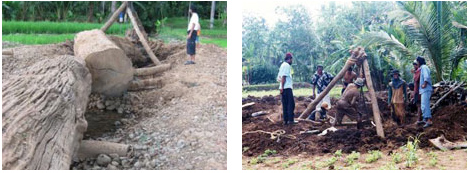 Salvaging entombed wood from volcanic soil and buried timber from an oil palm plantation. Courtesy of Tropical Salvage |
Mongabay: Do you see potential to expand the Tropical Salvage model to other parts of the world?
Tom O’Brien: Yes. We recently sent a first shipment to London. The reserved, more sober and perhaps more traditionally inclined English are still mulling what to make of it.
Mongabay: What about on the sourcing to Africa, Latin America, and other parts of Asia?
Tom O’Brien: We do see potential for that, and we have discussed the idea — though for the present and the short-term future, we have no definite intention of pursuing it. We are confident that this kind of work could make a difference in people’s lives there, and that there is great wood to be salvaged be salvaged in those places. There are other factors that contribute to the success of our business in Indonesia, notably:
- the skilled craftsmen to employ there (North Central Java has a long tradition of furniture-building and woodworking); and
- convenient logistics/shipping infrastructure (our facility on Java is very close to Semarang, a major port)
We simply don’t know much about where there might be appropriate existing wood products industries in South America or Africa (of course, training people in areas of economic hardship is always a possibility, too). We have imagined that the logistics/shipping facilities in central Africa are probably sparse, which could make it difficult/expensive to operate there.
Mongabay: Are you going to seek FSC-certification or does it not apply to the sort of harvesting you do?
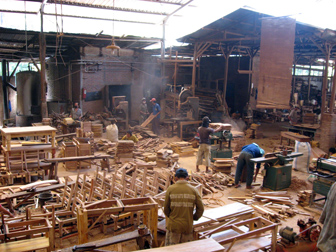 Production warehouse. Photo by Edward Wolf |
Tom O’Brien: If building projects seeking LEEDS certification show more interest in our work, we’ll seek FSC certification in order to participate in those projects. So far, achieving FSC certification hasn’t been relevant to the work we do. Additionally, our perspective on reasonable wood sourcing diverges with FSC in that, due to alarming diminishment of primary tropical forests and the ecosystems they sustain, we don’t believe any remaining primary tropical forests should be harvested, selectively or otherwise, to answer demand in the international marketplace. We believe science has strongly made the case that the values of these forests to human quality of life for their biodiversity, watershed protection, soil stability and carbon sequestration supersedes their value in answering consumer market desires for furniture and flooring derived from favored exotic woods.
Mongabay: How are customers responding to your offerings? Do customers show interest in other ways to support conservation in Indonesia?
Tom O’Brien: Tropical Salvage is a growing niche business. Some customer responses have been enthusiastic, some quizzical and others reserved. As I noted, we’re still unsure of what size market might exist for our somewhat innovative interpretation of beautiful and meaningful wood furniture. Many customers are very interested in and supportive of the issues we address by integrating business with social and environmental activism focused in Indonesia. Many sales are significantly influenced by our social and environmental work. However, if the products were not on their own, independent of TS’s mission objectives, well made, uniquely beautiful and good value the business could not exist.
Mongabay: How are locals responding to your efforts?
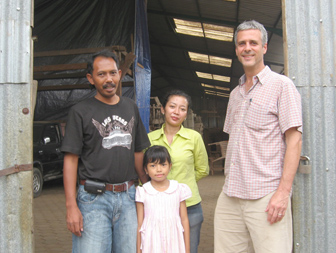 Tim, Agus, and Agus’ wife and daughter. Photo by Edward Wolf |
Tom O’Brien: Many Indonesians were perplexed when we began building products for the international marketplace using materials they regarded as garbage. Many, in fact, laughed out loud. Over time, though, as we’ve become and remained a stable employer while many other local furniture producers for mainstream markets have succumbed to competition from China and the global economic decline, we’ve gained considerable credibility and respect. Our assertive environmental education and forest restoration initiatives – tied to creating jobs – have compounded this credibility and respect.
It has been wonderful to observe an evolution of perspective that has occurred among many of Tropical Salvage’s employees. When we began the company, many employees were visibly unhappy with having to apply their efforts and skill to unfamiliar and very strangely sourced woods. Their previous furniture construction experience was limited to using straight-grained, uniformly hued, mostly plantation grown teak and luan mahogany. They thought the traditional formula, which was effectively popularized by the colonial Dutch some four-hundred years ago, equaled credibility in the international – developed world – marketplace. I think they considered Tropical Salvage’s business strategy a little embarrassing and shameful. Today, employees greatly prefer more uncommonly expressive wood grains and odder sourcing stories.
Mongabay: Tropical Salvage has an ambitious conservation project. Can you elaborate on this effort?
Tom O’Brien: Tropical Salvage integrates business with social and environmental activism because we understand the business community must join the lead in seeking solutions to unprecedented challenges to our world’s social and environmental integrity. In Indonesia, we create good, steady, eco-positive jobs and implement conservation, forest restoration and environmental education programs. In the United States, Canada and Europe, we advocate and strive to embody best responsible practices in the marketplace.
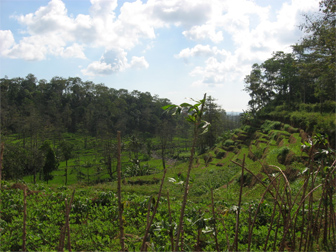 Jepara Forest Conservancy site. Photo by Edward Wolf |
Tropical Salvage has provided the seed capital for and significantly helped to shape and implement the Jepara Forest Conservancy, an Indonesian non-profit “yayasan” formed by a group of citizens from Jepara and Kudus concerned about environmental degradation and sustainable economic development on the Mount Muria peninsula, located in north central Java, Indonesia. Guiding the Jepara Forest Conservancy’s vision are principles that forestry-based climate change mitigation projects must be fully integrated with climate change adaptation strategies and that environmental protection is best achieved by working together with site communities to combine environmental objectives with generating sustainable livelihoods and cultural resilience. We will address climate change issues in ways that build just and equitable partnerships between communities in the developed and developing worlds. We identify challenges to equity arising from two conditions: 1) From effects of climate change on poor communities who are not cause contributors and lack resources to respond to them; and 2) From the developed world’s reluctance to adopt a “reduce first, offset last” carbon emissions policy which can lead to forestry-based carbon offset business models focused on offsetting developed world excesses to the distress of developing world ecosystems and cultures. Working through a broad stakeholder partnership based on international trade innovations, we aim to establish a very visible model program to demonstrate these principles can and should be integrated.
Project Description
-
JFC will shape land-use on the site to answer challenges caused by deforestation and climate change. The project will integrate a climate change mitigation facility with environmental restoration strategies that are climate change adaptive and build local food security, cultural resilience and sustainable economic opportunities [2].
Our proposed project is planned in two stages:
Stage 1: Demonstrating a concrete quick win
The first stage is intended to demonstrate the capacity of our partnership to effectively address community needs through restoration of ecosystem services and development of sustainable livelihood strategies. Although we will not develop a carbon offset facility in this first stage, we plan to demonstrate the efficacy of our methods for our application for certification to the Climate Communities and Biodiversity standards in stage 2.
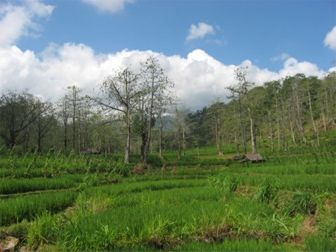 Jepara Forest Conservancy site. Photo by Edward Wolf |
Through the community-based GIS mapping conducted by Starling Resources we have identified a 34 ha site in the village of Kunir for this first stage). The site was chosen for its relatively easy access, degraded forest conditions and its highly forest-dependent community. Currently nearly all of the households in Kunir base their livelihoods on the use of the degraded protected forest (hutan lindung) above their village for subsistence agriculture. The forest degradation is a result of illegal logging activities that occurred between 1999 and 2004.
Results of interviews and meetings with community members have clarified community perceptions of the importance of ecosystem goods and services provided by the protected forest. The community members have identified several high-priority concerns for direct negative impacts to their health and livelihoods caused by degradations of these services. These impacts include damage to homes from high winds, landslide risk, soil degradation and erosion, and disappearance of natural sources of clean water
The reforestation initiative will practice principles of a “tumpangsari” (forest garden) which combines planting productive perennial species – to stimulate economic opportunity and establish a reliable local food source – with planting a broad mixture of native botanical species, many of which yield non-timber forest products that have traditional local uses, to intentionally revive and multiply the area’s ancestral biological diversity.
Additional project aims are to protect the area’s threatened natural sources of clean water, re-establish forest root-systems to abate soil erosion and reduce episodes of landslides, re-establish a forest canopy to buffer against strong winds, and expand forestland surrounding the site’s core of primary natural forest, which contributes importantly to sustaining a population of endangered Javan ebony langurs, among other species. JFC’s agreement with Perum Perhutani commits to a schedule to plant 60% native species and 40% agro-forestry species—such as coffee, cacao and cashew—and to practice organic cultivation.
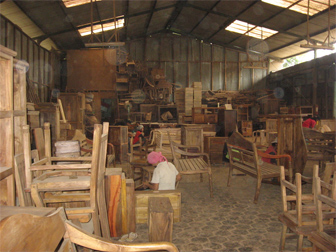 Tropical Salvage warehouse. Photo by Edward Wolf |
JFC will create economic opportunities for communities located near the project site by tailoring business strategies to increase product values. Specifically, product value enhancements will include: (1) converting entirely to organic cultivation; (2) creating facilities to refine and package (to add value to) products in order to sell them directly to markets where end products are assigned significantly higher value; (3) enabling JFC’s product set to become part of a strong and growing market presence already established by Tropical Salvage, and thereby benefit from support and loyalty of Tropical Salvage’s existing wholesale and retail customer base; (4) asserting a strong and broad brand presence that emphasizes the products’ enablement of a unique set of environmental and social benefits – good, steady, eco-positive jobs, cultural resilience, environmental education, and reforestation initiatives that protect watersheds and value native biodiversity. (Protection of the Javan ebony langur, or “lutung,” will importantly assist in shaping JFC’s brand.) Through their advantageous market qualifications, we expect products deriving from JFC’s organic forest garden to generate revenues that will create sustainable jobs in scalable numbers.
A Carbon Offset Credit Producer
-
Stage 2: Ramping up
In stage two we will expand the scope of the project to include the additional 226 ha of land specified in our MU with PP. During this stage of the project we will establish a carbon offset facility. We plan to produce offset credits certified through the Carbon, Communities and Biodiversity system. Among the available certification systems, we see the CCB as most alligned with our goals and principles, although we will exceed their standards to answer equity concerns. As our project is a partnership between Indonesia and North American-based partners, we will market the credits in the US and Canadien voluntary market.
In its role as a carbon offset facility, JFC has two main goals. First, we see sales of carbon offset credits playing an important role in establishing a sustainable funding stream to realize the project’s reforestation, conservation and community empowerment objectives. Our reforestation plan is not designed to optimize the carbon sequestration potential of the site, but rather, to find an equitable balance between carbon sequestration capacity and site community needs.
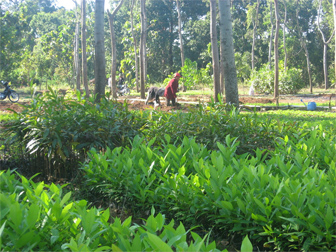 Seedlings for reforestation of Jepara Forest. Photo by Edward Wolf |
Our second goal is to serve as a model and a learning opportunity for best practices in the developing carbon trading markets, both voluntary and regulated. We are well-positioned to optimize carbon neutrality as an integral part of our branding strategy. Two of the partners, the Institute for Culture and Ecology and Tropical Salvage are based in Portland, Oregon. In recent years, Portland has established itself as a national leader in the USA for sustainability initiatives and in particular for innovation in the development of carbon trading mechanisms and, more broadly, ecosystem services marketplaces. Through efforts such as the Oregon-led Western Governors Climate Initiative, and the Willamette Valley Ecosystem Services Marketplace, Oregon bas become the place other US states and federal players look to for guidance in developing legitimate structures and governance practices. By engaging these initiatives, our project can significantly raise awareness about the crucial role of equity and justice as it pertains to carbon trading. The Institute for Culture and Ecology will take the lead in marketing credits generated by the project, using existing relationships with businesses committed to first reducing emissions before considering the purchase of offset credits. As one example, a coalition of more than 40 wineries in the Willamette Valley has committed to attaining carbon neutrality. Working through the Natural Step methodology they are making major strides in reducing emissions associated with their operations. However, due to systemic issues such as transportation, reduction to climate neutrality is not possible through emission reduction alone. They plan to bridge this gap through the purchase of offset credits. IFCAE has initiated discussions with this group and motivated their interest in eventually purchasing CCB-certified credits through our project. Many other examples could be cited. By establishing partnerships between our carbon offset facility and such businesses, we plan to establish a model of best-practices in the integration of climate change mitigation with mandates of equity and justice. As stated in a recent paper of Verchot, Van Noordwijk et al [3], “Agroforestry offers the potential to develop synergies between efforts to mitigate climate change and efforts to help vulnerable populations adapt to the negative consequences of climate change. The research agenda in this area is fairly well defined. Yet, much is already known and putting these ideas into practice on the ground with small-scale farmers will allow us to learn important lessons through practical experience.” Our project promises to offer just such an on-the-ground effort. In addition, due to our involvement with partners in Portland, our project has the potential to be a high-visibility model of best-practices and ethical standards in the developing carbon offset market.
Applying best practices international trade to build a strong and sustainable social and economic bridge between rural Indonesia and metropolitan America, Canada and Europe, we will facilitate cross-cultural understanding and respect. We are aware of the need for long-term accountability to the community in these market-based approaches and we will ensure that control of all agreements will lie entirely with the site communities.
In “Equity and justice in climate change adaptation amongst natural-resource-dependent societies” [4], Thomas and Twyman find that developing “economic space and capacity for diversification beyond and within natural-resource use” is crucial to addressing the adaptation needs of vulnerable communities, as is enhancing the “policy space that allows local level innovations and responses to evolve”. Through our public-private partnership approach and collaboration with Perum Perhutani, we aim to achieve exactly these results.
Mongabay: What are the future goals for the Jepara Forest Conservancy?
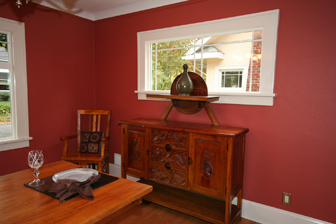 Tropical Salvage wood products. Tropical Salvage wood products.
|
Tom O’Brien: In the same way Tropical Salvage has evolved as a kind of sustainable wood-use lab, the first JFC forest restoration site is intended, to some extent, to serve as a sustainable land-use lab. Assisted by sustainable-business entrepreneurs, NGOs and academia, we will refine our understanding of organic agro-forestry techniques applied in forest gardens, we will explore potentials for developing products (agro-forestry, eco-tourism, carbon off-set credits) deriving from the site and seek efficient market entries for them, and we will collect data to track and understand both the area’s biodiversity and the forest’s rate of carbon sequestration. Successes we might realize we aim to replicate in other forest restoration opportunities located in Indonesian mountain watersheds.
Mongabay: How can people here in the U.S. support your efforts? Where are your products sold?
Tom O’Brien: Buy Tropical Salvage products. Donate money to the Jepara Forest Conservancy through The Institute for Culture and Ecology or Global Giving. (IFCAE receives 10% of such donations for their considerable administrative tasks.) Buy JFC products when they come to market. Tropical Salvage product vendors are listed on Tropical Salvage’s website. Many of these vendors will also sell JFC products.
References
- Naylor, R.L., et al., Assessing risks of climate variability and climate change for Indonesian rice agriculture. Proceedings of the National Academy of Sciences, 2007. 104(19): p. 7752.
- Although we have not conducted a census to determine average household income, anecdotal evidence from our participatory mapping—community-based GIS mapping of the site was conducted by Starling Resources (starlingresources.com) in March – May, 2008—finds that household income is very low and is vulnerable to further degradation of the local environment. Thus, building economic resilience in the community is a high priority.
- Verchot, L., et al., Climate change: linking adaptation and mitigation through agroforestry. Mitigation and Adaptation Strategies for Global Change, 2007. 12(5): p. 901-918.
- Thomas, D.S.G. and C. Twyman, Equity and justice in climate change adaptation amongst natural-resource-dependent societies. Global Environmental Change, 2005. 15(2): p. 115-124.